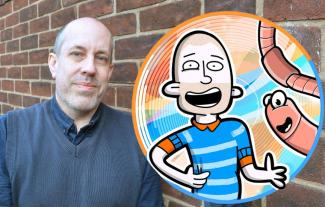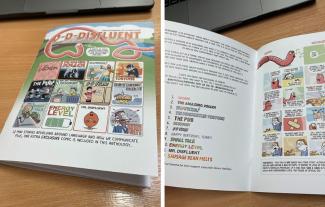When I'm drawing I can control the narrative

Comic artist Gareth Cowlin has been contributing pieces for us over the last year, and here tells us about his relationship with stammering and drawing.
My name is Gareth Cowlin and I'm the person who's been drawing the 12 mini-comics for STAMMA's Features section all about stammering. As the year-long project comes to an end, I decided to put them together into an anthology which I've called 'D-D-Disfluent' and this August I was invited to sell copies at the Cartoon Museum in London.
To coincide with my final mini-comic, 'Sausage Bean Melts', STAMMA wondered if I'd like to write a little bit about me and how the comics came about.
Whenever I think back to where my love for comics and comic art originated, I instantly picture myself around seven years old, hunched over a spread of Buster or Transformer comics on the living room floor. Most of my school exercise books had Optimus Prime haphazardly, but passionately, drawn in them.
I suppose that's why I like drawing so much... I can tell a story without interruptions and it's my pure 'voice'.
I did a film & video degree and then studied the history of graphic novels for my MA in graphic communication. During my first degree, I began drawing cartoons for various publications. It started as a hobby, initially, and then developed into a very rewarding career. Over the last few years, I have regularly produced work for magazines and newspapers including Private Eye, Punch, The Sun, The Bookseller and The New Statesman. I have received several awards recognising my work and my illustrations have been sold for charity.
Hiding my stammer
It's only over the last few years that I've come to realise the underlying impact that stammering has had on my life. I have been mildly disfluent since childhood and I remember my stammer always being a part of my character. As I grew up, I became more aware of the types of words that would be problematic and I'd use an alternative word. It became relatively easy, if a bit linguistically limiting. Then, I found that I was naturally doing it, and people didn't notice.
Over the years, I've had several conversations that go like this:
Him: "Are you disfluent yourself?"
Me: "I have my moments."
Him: "Oh, right, I never noticed. You're lucky that it doesn't affect you."
I have become very good at hiding my stammer. However, the difference between something being 'hidden' and 'gone' is quite important.
As an example, let's consider a conversation like the one above. The line "I have my moments" might have originally been "Yes, I stammer occasionally," but just as I'm about to utter it a little alarm goes off in my head, reminding me that sometime in the past I struggled with the word 'occasionally'. I then have a choice: attempt it or find an alternative word. Depending on who I'm with, I'll most often go for the substitute word or phrase.
To be completely honest, it's got to the point where I can't quite remember which words I stammer on. I know I still do, because it happens when I can't switch a word out, such as a street name or film title.
Her: "What did you last see in the cinema?"
(It was Mission Impossible)
Me: "Oh, it was that Tom Cruise thing."
Her: "Mission Impossible? Yes, I saw that."
People don't notice it. I don't always notice it, it's become second nature.
There are some specific words that I struggle with. One tends to be 'congratulations', which I'm not really required to use that often but when I do it does tend to catch me out, as there are so few alternative words that land in the same way…
Married Couple: "We're pregnant!"
Congratulations
Me: "Well done."
Of course, this 'counter-productive avoidance behaviour' (i.e. burying the stammer way down) can be pretty physiologically damaging and is not recommended as a coping technique.
Why is it damaging? Well, I'm sure most of you are about a paragraph ahead here, but I developed into some sort of shadow of who I should be. An alternative person, compromised. I often avoid social situations and phone calls. My job at Staffordshire University as a lecturer is a direct attempt to counteract the instinctive need to shy away. Like someone who has a phobia of frogs being placed into a box of frogs (I'm not equating my students with frogs. Well, not all of them.)

Controlling the narrative
Small talk and chit-chat are sometimes tricky, as the pace of conversation occasionally exceeds my ability to find alternative words. I worry that I come across as distant, or too quiet in social situations. The old proverb 'It's better to remain silent and be thought a fool than to speak and remove all doubt' often springs to mind.
I suppose that's why I like drawing so much, I can control the narrative. I can tell a story without interruptions and it's my pure 'voice'.
Interestingly, many Creative Arts students seem to have a higher range of differing needs than students on other courses. Most of these issues tend to revolve around how they are perceived by others. I've often wondered if a vocation in the Arts offers some way for people to control their world more. By producing paintings, photographs, films etc. They are 100% in control of these outcomes.
I'd like to explore this idea further in the future. Who knows, maybe it might form the basis for another set of stories? D-D-Disfluent Volume 2, perhaps?
Follow Gareth's work on social media (@garethcowlin) or email him at garethcowlin@gmail.com if you'd like to get in touch.
Would you like to write for an article? Tell us about your journey with stammering, or about something you've created. See Submit Something For The Site or email editor@stamma.org

































